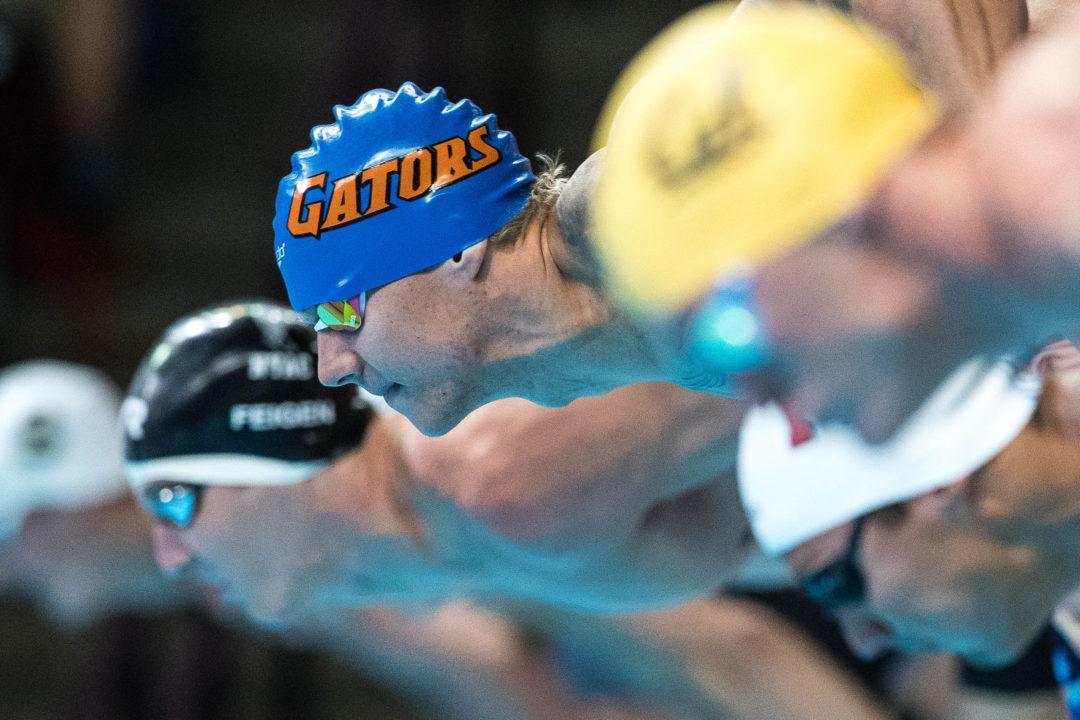This post originally appeared at YourSwimBook.com. You can join Olivier’s motivational newsletter for competitive swimmers by clicking here.
In theory, tapering should be fairly straightforward for swimmers.
You come down in mileage, up the quality efforts a little bit here and there, fine tune the technical aspects of your training, and then smash your personal best times at the big goal meet.
In my own experience, as well as the countless swimmers I have spoken to over the years, tapering is just a trying period as the holiday training camp and hell week. Although the physiological workload comes down, it becomes a daily mental battle working through a reduction in yards and escalation of expectation.
After all, during the swimming taper we come to think that our bodies should be primed. That we should feel fantastic in the water. And that everything in and out of the pool has to be perfect otherwise our expectations for the big meet go into a violent free fall.
The next time you start getting rested up for the big meet, here are 11 things to remember so that you can keep the taper blues in check:
1. The way your body responds to rest isn’t always completely clear.
Sometimes you will feel rested and ready to rock a couple days into the taper.
Other times it will be literally the day before the meet that the taper and rest has caught up to you and applied itself.
Trusting the process is difficult when the proof or results aren’t immediately apparent.
During the taper is when you are making all of the physiological consolidations of months and months of training– it won’t happen overnight, nor will it happen after a couple days.
2. Don’t look elsewhere to compensate for a lack of activity.
When the rest kicks in you feel on top of the world. With all of the surplus energy it is natural to look elsewhere for an outlet to dump in.
Feeling like a million bucks before a particular competition back in the day I thought it would be a great idea to duck into the gym and lift some weights real quickly.
The only problem? Hadn’t lifted in months, and I didn’t bother stretching, leaving me with a strained bicep tendon a couple days out of the big meet.
Real S-M-R-T.
3. Use your competition gear in practice.
Try the brand new suit, expensive new goggles, cap and ear plugs in practice before you go to the meet.
Practice is the time to play around and try new things, not the moments before the big race.
4. Do some dress rehearsals.
One way to do this is to walk up and down the pool deck at the speed you plan on swimming. This will give you a physical sense of the speed you want to hit without having to throw down a full blown effort a couple days out from the meet.
Mental rehearsals are another great way to prepare for the meet.
Visualize your race, the way you are going to get ready beforehand, how you feel in the water, and how awesome it will feel when you hit the wall and destroy that best time.
5. Taper means rest, but not complete rest.
You’ve already put in a ton of work, don’t let it go to waste by completely arresting all of your training in the two weeks leading up to the big meet.
Taper is a time for your body to recover, yes, but it is also a time where you fine tune the details of your swimming. I have seen swimmers self-taper by passing on workouts in order to better rest themselves, only leaving themselves feeling sluggish by the time the meet came around.
6. Starts and turns.
Odds are good that you have now begun to think about these aspects of your swimming again. (In reality, you should be working on these bad boys year round, not just when you are in the final days before a competition.)
Doing turns at speed means you will avoid making the same mistake Michael Phelps made at US Nationals in the summer of 2014 when he missed the wall turning in the 100m freestyle final.
Diving from the side of the pool 7-8 meters out from the wall and sprinting in and turning is a great way to work on executing turns at race speed.
7. Avoid the urge to become a Google doctor.
It’s funny—when we are in the middle of a ridiculous bout of training our body will be littered with soreness and aches. But the moment we get into the taper phase of training we expect everything to feel perfect.
A soreness or ache will be dissected, over-analyzed, and Google’d. (Google is the worst way to figure out what is wrong with you. No matter what the symptom, you will always fixate on the absolute worst possible diagnosis.)
Some taper soreness is actually quite natural, particularly with those fast twitch muscle fibers that are now being fully maxed out during high quality reps in the pool.
8. Now is not the time to experiment with a new technique.
One of my favorite quotes that exemplifies this is from college football coach, Chip Kelly, “You don’t rise to the occasion, you sink to the level of your preparation.”
If you want to change to a straight arm freestyle recovery because you saw some fast swimmers do it on YouTube, by all means do so, after the big meet.
When in competition you want to be able to turn off your mind and race in the moment instead of focusing on the technical aspects of your swimming. Getting technical is for practice.
9. Swim faster by sleeping more.
Just because we are cutting back the meters and yards in the pool doesn’t mean that we should be staying up all night with that new-found energy.
You should be just as focused on getting a ton of sleep each night to maximize recovery during the taper or fine-tuning period as you are during hard training.
The effects of even an extra hour of sleep a night have been shown to improve performance drastically, so don’t underestimate the benefits of spending that quality time with your pillow.
In terms of performance aids, this is as easy as it gets.
10. Don’t freak out, this taper thing works.
No matter how stressed or anxious you are getting in the days leading up to the meet, remember that tapering works.
Comprehensive research has shown that most athletes can expect a 2-3% improvement in performance as a result of tapering (with some experiencing as high as a 6% boost—a.k.a. the “meet” swimmer).
If this is your first taper, take a breath and remember that the nervousness and second doubting are practically part of the process.
And for those who are going through their umpteenth taper, you already know that it works, so sit back, rest up, and enjoy the fruits of your hard work!
11. We all respond slightly differently.
There are a myriad of factors that go into how we respond to the taper phase.
A two-a-day extra lean distance swimmer is going to have a different reaction to coming down in training than a one-a-day muscled-out sprinter.
It’s understandable that you are going to want to look over in the lane next to you at practice and compare yourself to your teammates, but your taper response is unique to your training background, your event, your physiology, and all of the out of the water conditions that differentiate.
Take Your Swimming to the Next Level
 YourSwimBook is a log book and goal-setting guide designed specifically for competitive swimmers.
YourSwimBook is a log book and goal-setting guide designed specifically for competitive swimmers.
It includes a ten-month log book, a comprehensive goal-setting section, monthly evaluations to be filled out with your coach, and more.
👉 Learn 8 more reasons why this tool kicks butt now.
Join the YourSwimBook weekly newsletter and get motivational tips and more straight to your inbox.

Does anyone here think that 10 or 11 is a bit to young for tapering?
Not necessarily…
I highly disagree with 3. I agree that goggles could be used, but not the racing suit. Do you know how much it costs? We aren’t all Bill Gates here.
Yes, you can still take out the trash for your mom.
I don’t think anyone actually tries to use the taper as an excuse, just a joke that kinda passed around.
Can SwimSwam publish an article on how Masters swimmers should taper?
I’m sure a lot of former college swimmers in their 20s and 30s are looking for a proper way to taper. Transitioning from 20-30 hours of training each week at the college level to 6-10 hours of training each week at Masters level requires a change in the way a swimmer tapers.
In my opinion, Masters swimmers who are putting in 15k a week do not need to cut back the same way college swimmers do. Two weeks before a major competition weight training should be reduced to basic injury prevention reps and pool work should focus more on speed work with long rest intervals.
TAK, I tapered for spring nationals and followed a similar taper strategy you mentioned. I swam very close to my PBs so it worked out well. I’m just interested in see what the experts recommend.